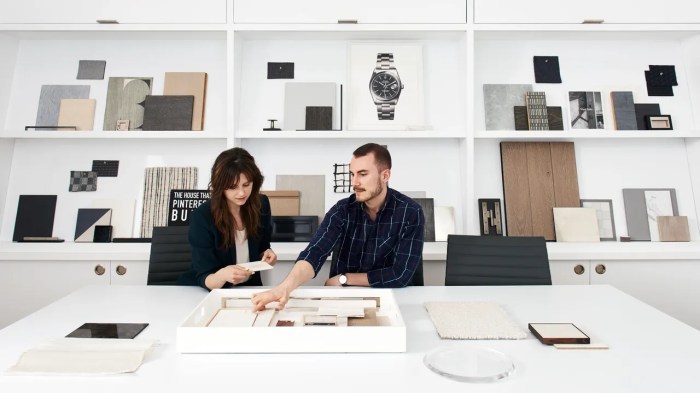Exploring the Roles of an Architect and Interior Designer
Embark on a journey into the world of architects and interior designers, where creativity and functionality collide to shape our living spaces. This introduction sets the stage for a deep dive into the distinct yet interconnected realms of design and innovation.
In the following paragraphs, we will unravel the key aspects of these professions, shedding light on their roles, education, design processes, skills, and the vital importance of collaboration.
Roles and Responsibilities
An architect plays a crucial role in a design project by focusing on the overall structure, spatial functionality, and aesthetics of a building. They are responsible for creating detailed plans, coordinating with engineers and contractors, and ensuring that the design meets building codes and regulations.Interior designers, on the other hand, are responsible for enhancing the interior spaces of a building.
They focus on factors such as color schemes, furniture selection, lighting, and decor to create a cohesive and visually appealing environment. In a collaborative project, interior designers work closely with architects to ensure that the interior design complements the overall architectural vision.
Comparing Architect and Interior Designer Roles
- Architects focus on the overall structure and exterior design of a building, while interior designers focus on the interior spaces.
- Architects are trained to deal with structural elements and building systems, while interior designers specialize in creating functional and aesthetically pleasing interior environments.
- Architects work on a macro scale, considering the entire building, while interior designers work on a micro scale, focusing on individual rooms and spaces.
- Architects typically lead the design process and coordinate with various professionals, while interior designers collaborate with architects to ensure a cohesive design approach.
Education and Training

In the fields of architecture and interior design, education and training play a crucial role in shaping the careers of professionals. Let's delve into the typical educational paths and necessary qualifications for these professions.
Architect
To become an architect, one typically follows a structured educational path that includes obtaining a professional degree in architecture. This can be a Bachelor of Architecture (B.Arch) or a Master of Architecture (M.Arch) from an accredited institution. Additionally, aspiring architects usually complete an internship or work experience under a licensed architect to gain practical knowledge and skills in the field.
- Complete a professional degree in architecture (B.Arch or M.Arch).
- Participate in internships or work experience under a licensed architect.
- Pass the Architect Registration Examination (ARE) to become licensed.
Interior Designer
For a career in interior design, individuals need to possess the necessary qualifications to excel in the field. This typically involves obtaining a degree in interior design or a related field, such as interior architecture. While formal education is important, having a creative eye, attention to detail, and excellent communication skills are also essential for success in interior design.
- Obtain a degree in interior design or a related field.
- Develop a strong portfolio showcasing design skills and projects.
- Stay updated on industry trends and technologies.
Specialized Training and Certifications
In addition to formal education, architects and interior designers may pursue specialized training or certifications to enhance their skills and credibility in the industry. For architects, obtaining LEED (Leadership in Energy and Environmental Design) certification can demonstrate expertise in sustainable design practices.
Similarly, interior designers may choose to become NCIDQ (National Council for Interior Design Qualification) certified to showcase their proficiency in the field.
- Architects can pursue LEED certification for sustainable design practices.
- Interior designers may opt for NCIDQ certification for professional recognition.
- Continuing education and workshops help professionals stay updated on industry standards.
Design Process
In the field of architecture and interior design, the design process is a crucial aspect that guides professionals in creating functional and aesthetically pleasing spaces. Let's explore the steps involved in the architectural design process and how interior designers conceptualize and execute their design ideas.
Architectural Design Process
The architectural design process typically involves the following steps:
- Programming: Understanding the requirements and objectives of the project.
- Schematic Design: Developing initial design concepts and sketches.
- Design Development: Refining the concepts, integrating structural systems, and finalizing materials.
- Construction Documents: Creating detailed drawings and specifications for construction.
- Bidding and Negotiation: Obtaining construction bids and selecting a contractor.
- Construction Administration: Overseeing the construction process to ensure the design is implemented correctly.
Interior Design Process
Interior designers also follow a structured design process, which includes:
- Initial Consultation: Understanding the client's needs, preferences, and budget.
- Concept Development: Creating mood boards, color schemes, and layout plans.
- Design Implementation: Selecting furniture, finishes, and decor elements to bring the concept to life.
- Project Management: Coordinating with contractors, vendors, and other professionals during the execution phase.
- Final Installation: Placing and styling the furniture and accessories to complete the design.
Comparison of Design Processes
While both architects and interior designers share similarities in their design processes, they differ in terms of scale, focus, and technical requirements. Architects typically work on the overall structure and form of a building, while interior designers focus on the interior spaces and how they function for occupants.
Architects may collaborate with interior designers to ensure a cohesive design that integrates both the building's exterior and interior elements seamlessly.
Skills and Expertise
To excel in their professions, architects and interior designers require a specific set of skills and expertise that contribute to the successful completion of projects. Let's delve into the key skills needed for architects and the expertise required for interior designers to create functional spaces, as well as how their skill sets complement each other in a project.
Key Skills for Architects
Architects need to possess a combination of technical, creative, and analytical skills to thrive in their profession. Some key skills include:
- Design Skills: Ability to conceptualize and develop innovative design solutions that meet client needs and project requirements.
- Technical Proficiency: Knowledge of building codes, construction methods, and materials to ensure the structural integrity of designs.
- Problem-Solving Skills: Capacity to identify and address design challenges effectively and efficiently.
- Communication Skills: Strong communication skills to collaborate with clients, engineers, contractors, and other professionals involved in the project.
- Project Management Skills: Ability to manage multiple tasks, timelines, and budgets to ensure the successful execution of projects.
Expertise for Interior Designers
Interior designers specialize in creating functional and aesthetically pleasing interior spaces. To achieve this, they need expertise in various areas such as:
- Space Planning: Ability to optimize the layout and flow of interior spaces to enhance functionality and usability.
- Color Theory and Material Selection: Knowledge of color schemes, textures, and materials to create cohesive and visually appealing designs.
- Lighting Design: Understanding of lighting principles to enhance ambiance and mood within a space.
- Furniture and Fixture Selection: Skill in selecting furniture and fixtures that complement the overall design concept and meet client preferences.
- Attention to Detail: Focus on the finer details that elevate the design and create a polished end result.
Complementary Skill Sets
The skill sets of architects and interior designers complement each other in a project by combining technical expertise with creative vision. Architects focus on the overall structure and form of a building, while interior designers enhance the interior environment through their expertise in spatial planning, aesthetics, and detailing.
This collaboration ensures that both the exterior and interior of a space harmonize seamlessly to create a cohesive and functional design that meets the needs and preferences of clients.
Collaboration and Communication
Collaboration between architects and interior designers is crucial for the success of a project. It allows both professionals to combine their expertise, creativity, and vision to create cohesive and functional spaces that meet the needs and desires of the client.
Effective communication between architects and interior designers is essential throughout the design process to ensure that the project stays on track, deadlines are met, and the final result reflects the original vision.
Importance of Collaboration
Collaboration between architects and interior designers ensures that the overall design of a space is cohesive and well-integrated. By working together, they can address both the structural and aesthetic aspects of a project, resulting in a harmonious and functional space that meets the client's requirements.
- Architects focus on the structural elements of a building, such as layout, circulation, and building systems, while interior designers concentrate on the aesthetics, finishes, furniture, and decor.
- Collaboration allows for a seamless integration of these aspects, ensuring that the final design is not only visually appealing but also practical and functional.
- By sharing ideas, feedback, and expertise, architects and interior designers can push the boundaries of design and come up with innovative solutions that elevate the project.
Impact of Communication
Effective communication between architects and interior designers is key to the success of a project. It helps in aligning goals, setting expectations, resolving conflicts, and ensuring that the design intent is accurately translated into the built environment.
Clear and open communication fosters a collaborative environment where ideas can flow freely, feedback can be given constructively, and decisions can be made efficiently.
Examples of Collaboration in Real Projects
In the renovation of a boutique hotel, the architect and interior designer worked closely together to transform the space into a modern and inviting environment. The architect focused on optimizing the layout and improving the structural integrity of the building, while the interior designer selected furnishings, finishes, and lighting to create a cohesive and luxurious ambiance.Another example is a residential project where the architect and interior designer collaborated to design a sustainable and energy-efficient home.
The architect incorporated passive design strategies to maximize natural light and ventilation, while the interior designer selected eco-friendly materials and furnishings to enhance the overall sustainability of the space.
Summary
As we conclude our exploration of architects and interior designers, it becomes evident that their harmonious collaboration is essential for creating spaces that inspire and elevate the human experience. This discussion highlights the symbiotic relationship between architecture and interior design, showcasing the artistry and precision required in crafting exceptional environments.
Essential FAQs
What sets architects apart from interior designers?
Architects focus on the overall design and structure of a building, while interior designers specialize in creating functional and aesthetically pleasing interior spaces.
Do architects and interior designers work together on projects?
Yes, collaboration between architects and interior designers is crucial to ensure a cohesive and well-integrated design that considers both the exterior and interior aspects of a space.
What qualifications are required to become an interior designer?
Typically, a bachelor's degree in interior design or a related field is necessary, along with a creative eye for design and a thorough understanding of space planning.
How do architects approach the design process?
Architects start by understanding the client's needs and vision, then proceed to create detailed plans and blueprints that Artikel the structure and functionality of the building.




